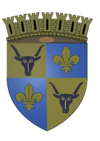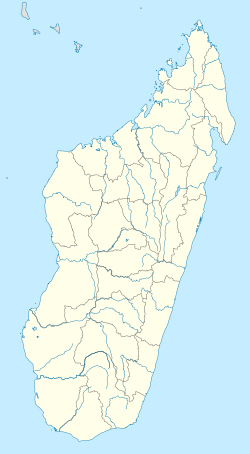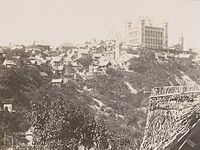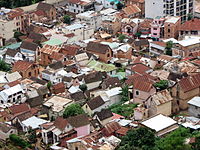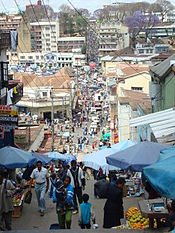
Antananarivo
Background Information
SOS Children made this Wikipedia selection alongside other schools resources. With SOS Children you can choose to sponsor children in over a hundred countries
| Antananarivo Tananarive |
|||
|---|---|---|---|
| Central Antananarivo, including Lake Anosy | |||
|
|||
| Nickname(s): Tana | |||
|
|
|||
| Coordinates: 18°56′S 47°31′E | |||
| Country | Madagascar | ||
| Province | Antananarivo Province | ||
| Founded | 1625 | ||
| Government | |||
| • Mayor | disputed | ||
| Area | |||
| • Total | 88 km2 (34 sq mi) | ||
| Elevation | 1,276 m (4,186 ft) | ||
| Population (2012 est.) | |||
| • Total | 1,918,117 | ||
| • Density | 22,000/km2 (56,000/sq mi) | ||
| Time zone | East African Time (GMT+3) | ||
| Area code(s) | (+261) 023 | ||
| Website | www.mairie-antananarivo.mg (French) | ||
Antananarivo (pron.: / ˌ æ n t ə ˌ n æ n ə ˈ r iː v oʊ /; Malagasy [antaˈnanaˈrivʷ], from Tanànan'ny Arivolahy), formerly Tananarive (pron.: / t ə ˌ n æ n ə ˈ r iː v / or / t ə ˌ n ɑː n ə ˈ r iː v /), is the capital and largest city in Madagascar. It is also known by its French colonial shorthand form Tana. The larger urban area surrounding the city, known as Antananarivo-Renivohitra ("Antananarivo-Mother Hill" or "Antananarivo-Capital"), is the capital of Analamanga Region.
Location
Antananarivo is situated in the centre of the island length-wise, and 145 km (90 mi) away from the eastern coast. The city occupies a commanding position, being built on the summit and slopes of a long and narrow rocky ridge, which extends north and south for about 4 km (2 mi) and rises at its highest point to about 200 m (660 ft) above the extensive rice plain to the west, although the town is at about 1,275 m (4,183 ft) above sea level. It is Madagascar's largest city and is its administrative, communications, and economic centre. The city is located 215 km (134 mi) west-southwest of Toamasina, the principal seaport of the island, with which it is connected by railway, and for about 100 km (62 mi) along the coastal lagoons..
History
Unlike most capital cities in southern Africa, Antananarivo was already a major city before the colonial era. The city was founded circa 1625 by King Andrianjaka and takes its name (the City of the Thousand) from the number of soldiers assigned to guard it. For many years it was the principal village of the Hova chiefs and gained importance as those chiefs made themselves sovereigns of the greater part of Madagascar, eventually becoming a town of some 80,000 inhabitants.
In 1793 Antananarivo was made the capital of the Merina kings. The conquests of King Radama I made it the capital of almost all of Madagascar. The royal residence of the monarchs was set up at the Rova of Antananarivo. Until 1869 all buildings within the city proper were of wood or rushes and followed traditional Malagasy architectural norms, but even then it possessed several timber palaces of considerable size, the largest being 120 ft (37 m) high. These crown the summit of the central portion of the ridge; and the largest palace, with its lofty roof and towers, is the most conspicuous object from every point of view.
Since the introduction of stone and brick by James Cameron and other London Missionary Society missionaries in the early 19th century, the entire city has been rebuilt and now contains numerous European-style structures, including the royal palaces, the houses formerly belonging to the prime minister and nobles, the French residency, the Anglican and Roman Catholic cathedrals, and several stone churches. The Museum of Ethnology and Paleontology is located in the city.
Present day
The city was captured by the French in 1895 and incorporated into their Madagascar protectorate. After the French conquest of Madagascar when the city had a population of some 100,000, it was extensively remodeled as the population grew to 175,000 by 1950. Roads were constructed throughout the city, broad flights of steps connecting places too steep for the formation of carriage roads were built, and the central space, called Andohalo, was enhanced with walks, terraces, flower-beds and trees. Water, previously obtained from springs at the foot of the hill, was brought from the Ikopa River which skirts the capital to the south and west.
After independence in 1960 the pace of growth increased rapidly. The city's population reached 1.4 million by the end of the 20th century. Industries include food products, cigarettes, and textiles.
The city is guarded by two forts built on hills to the east. Including an Anglican and a Roman Catholic cathedral (this is the see city of the Roman Catholic Archdiocese of Antananarivo), there are more than 5,000 church buildings in the city and its suburbs. Antananarivo hosts a campus of the University of Madagascar and the Collège Rural d'Ambatobe. Ivato Airport serves the city with several regional routes and flights to and from Paris, Johannesburg and Nairobi among other cities.
Michele Ratsivalaka succeeded Andry Rajoelina as mayor. Rajoelina replaced Marc Ravalomanana as president during the 2009 Malagasy political crisis.
Climate
Antananarivo has a temperate climate. Under the Köppen climate classification, the city features a subtropical highland climate (Cwb). Owing to its high elevation of 1,300 to 1,400 metres (4,265 to 4,593 ft) above sea level, the city is known for its mild climate. Antananarivo receives practically all of its average annual rainfall between November and April. The dry season is usually mild and sunny, however the nights are chilly. Although frosts are rare in Antananarivo, they are more common at higher elevations. Means range from 22.2 °C (72.0 °F) to 15.3 °C (59.5 °F).
| Climate data for Antananarivo | |||||||||||||
|---|---|---|---|---|---|---|---|---|---|---|---|---|---|
| Month | Jan | Feb | Mar | Apr | May | Jun | Jul | Aug | Sep | Oct | Nov | Dec | Year |
| Record high °C (°F) | 33 (91) |
32 (90) |
31 (88) |
31 (88) |
29 (84) |
27 (81) |
27 (81) |
29 (84) |
33 (91) |
35 (95) |
34 (93) |
33 (91) |
35 (95) |
| Average high °C (°F) | 27.7 (81.9) |
25.9 (78.6) |
25.4 (77.7) |
24.8 (76.6) |
22.9 (73.2) |
20.9 (69.6) |
20.2 (68.4) |
20.6 (69.1) |
23.0 (73.4) |
25.2 (77.4) |
26.0 (78.8) |
25.8 (78.4) |
24.0 (75.2) |
| Average low °C (°F) | 16.6 (61.9) |
16.9 (62.4) |
16.3 (61.3) |
15.2 (59.4) |
12.9 (55.2) |
10.8 (51.4) |
10.3 (50.5) |
10.3 (50.5) |
11.3 (52.3) |
13.4 (56.1) |
15.1 (59.2) |
16.3 (61.3) |
13.8 (56.8) |
| Record low °C (°F) | 12 (54) |
11 (52) |
11 (52) |
7 (45) |
4 (39) |
1 (34) |
3 (37) |
2 (36) |
3 (37) |
6 (43) |
6 (43) |
11 (52) |
1 (34) |
| Rainfall mm (inches) | 270.4 (10.646) |
256.9 (10.114) |
183.1 (7.209) |
50.5 (1.988) |
20.1 (0.791) |
7.2 (0.283) |
11.1 (0.437) |
15.0 (0.591) |
9.5 (0.374) |
66.6 (2.622) |
170.8 (6.724) |
304.1 (11.972) |
1,365.3 (53.752) |
| Avg. rainy days | 18 | 17 | 17 | 9 | 6 | 6 | 8 | 9 | 4 | 8 | 14 | 20 | 136 |
| Mean monthly sunshine hours | 210.8 | 179.2 | 198.4 | 219.0 | 229.4 | 207.0 | 213.9 | 235.6 | 249.0 | 251.1 | 234.0 | 201.5 | 2,628.9 |
Landmarks
- Rovan'i Manjakamiadana
- Andafiavaratra Palace
- Tsimbazaza Zoo
International relations
Twin towns — Sister cities
 Yerevan, Armenia
Yerevan, Armenia Suzhou, People's Republic of China
Suzhou, People's Republic of China Nice, France
Nice, France Vorkuta, Russia
Vorkuta, Russia

